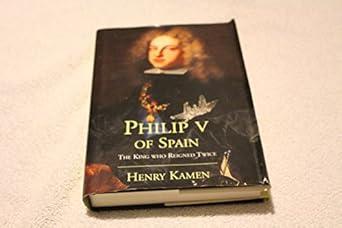
Download the free Kindle app and start reading Kindle books instantly on your smartphone, tablet, or computer - no Kindle device required.
Read instantly on your browser with Kindle for Web.
Using your mobile phone camera - scan the code below and download the Kindle app.

Philip V of Spain: The King Who Reigned Twice Hardcover – May 1, 2001
Drawing on contemporary opinion and fresh archival sources, Kamen discusses Philip's character, decisions and policies. He offers a new assessment of the king's illness (which led earlier historians to view Philip as mad) and re-evaluates the role of his two wives. Kamen's account of Philip as king also provides an essential introduction to the study of early eighteenth-century Spain and the Bourbon monarchy.
- Print length336 pages
- LanguageEnglish
- PublisherYale University Press
- Publication dateMay 1, 2001
- Dimensions6.25 x 1.25 x 9.5 inches
- ISBN-100300087187
- ISBN-13978-0300087185
The Amazon Book Review
Book recommendations, author interviews, editors' picks, and more. Read it now
Customers who viewed this item also viewed
Editorial Reviews
From Publishers Weekly
Copyright 2001 Cahners Business Information, Inc.
From Booklist
Copyright © American Library Association. All rights reserved
Review
About the Author
Product details
- Publisher : Yale University Press; First Edition (May 1, 2001)
- Language : English
- Hardcover : 336 pages
- ISBN-10 : 0300087187
- ISBN-13 : 978-0300087185
- Item Weight : 1.5 pounds
- Dimensions : 6.25 x 1.25 x 9.5 inches
- Best Sellers Rank: #2,567,876 in Books (See Top 100 in Books)
- #3,411 in Royalty Biographies
- #39,975 in Historical Biographies (Books)
- Customer Reviews:
About the author

Discover more of the author’s books, see similar authors, read book recommendations and more.
Customer reviews
Customer Reviews, including Product Star Ratings help customers to learn more about the product and decide whether it is the right product for them.
To calculate the overall star rating and percentage breakdown by star, we don’t use a simple average. Instead, our system considers things like how recent a review is and if the reviewer bought the item on Amazon. It also analyzed reviews to verify trustworthiness.
Learn more how customers reviews work on Amazon-
Top reviews
Top reviews from the United States
There was a problem filtering reviews right now. Please try again later.
Henry A.F. Kamen
New Haven and London: The Yale University Press, 2001
ISBN-10: 0300087187
ISBN-13: 978-0300087185
Review by Reverend Brian Van Hove, S.J.
Alma, Michigan
Published in the Josephinum Quarterly, vol. 10, no. 1 (Winter/Spring 2003): 158-160
Some years ago it was fashionable to write psycho-history, but that era has passed. Nonetheless Henry Kamen has given us today a well documented history which depends upon a specific psychological interpretation of Philip V, the French-born Bourbon King of Spain, who ruled there for forty-six years. The life of the king and the country was dominated by the bipolar disorder or manic depression from which the Philip suffered all his life. With the aging process, the monarch's behavior became only more bizarre and uncontrollable in the eighteenth century before our knowledge of contemporary medication. On page 190 we read, "For the better part of 1732, the king had not been governing Spain." Again on page 214, "In August that year (1738) Keene reported that when the king `retires to dinner, he sets up frightful howlings'." The illness was crippling for him and consequently for the affairs of state when Spain, still with the largest empire on earth, was entering into a period of gradual decline.
Were it not for his attentive wives--he was married twice--perhaps he might not have achieved anything at all. "Perhaps the most impressive achievement of Philip V's regime had been its efficiency in finding revenue to meet its needs. Government income had risen dramatically after the War of Succession [1704-1715], and the expeditions to Sardinia and Sicily had taken place without generating any financial crisis." (page 208) Some courtiers accused him of giving to much time to conjugal relations, though marital bliss seemed to help his spirits. For much of his reign only the care of his wife and the preparations for war seemed to lift the depression and bring him up into his hyperactive phase, but even then not consistently. During his first reign the War of the Spanish Succession occupied his youthful energies. He and his grandfather collaborated on strategy. The king loved both the war and his wife, Marie Louise, upon whom he depended for everything. But when the war was finally over not even his wife could keep him from sinking into deep depression.
After 1737 the king did finally find an effective therapy in the beautiful singing voice of the Italian castrato Carlo Broschi, known as Farinelli, who was even incorporated into the royal household. Unfortunately this took place toward the end of Philip's life which came suddenly at two in the afternoon on July 9, 1746, when he was just sixty-two years old.
Kamen wrote this biography to correct the record. Previous authors had portrayed the king in a negative way, making of him a kind of fool and failure at the beginning of the Age of Reason. Instead, we now learn from the best sources which have survived that Philip V was both lucid and intellectually coherent, though a very sick man who spent weeks and even months in bed. The charge that he was under the control of his wives is demonstrated to be false when we understand that they were doing their duty to "cover" for him when he was too dysfunctional to speak for himself. "When he was seriously indisposed, she forbade any access to him, which inevitably irritated both diplomats and members of the government." (page 206) Though after 1727 Elizabeth Farnese had the powers of governor and even directed foreign policy, she never made major decisions independently of her royal husband (page 162). Generally, Philip's wives promoted only his policies, not their own, as did also his faithful ministers whom Kamen goes to some length to introduce to us. Sadly, the fire in the Alcázar of Madrid on December 24, 1734, destroyed a great deal of what might have been quite useful for the present study.
As a very young man Philip, then the duke of Anjou, was required to renounce his claim to the throne of France if he were to rule Spain. He had a Spanish grandmother and a French grandfather, though he always felt French by culture. For political reasons this grandfather, the Sun King Louis XIV who had married the daughter of Philip IV of Spain in 1660, fully concurred in this decision for the felicity and peace of Europe (page 5). The last Habsburg king of Spain had died on November 1, 1700, and so after some negotiations Philip accepted the throne of Spain. Yet the dream of returning to rule France never completely left Philip. At times he also supported the claim of his son to succeed to the throne of France.
To complicate the story, Philip abdicated the Spanish monarchy to pursue with his wife the eternal salvation of their souls. Probably this religious zeal was in response to his illness or a pious front to hide the real reason. But even before and after that decision he had tried several times in the midst of serious depression to abdicate secretly though in an irrational and disorderly way. Government must be rational, and a variety of factors must be recognized for a peaceful transition to take place. Therefore his illness was not to be allowed to control the succession in Spain. Once he was barely stopped by the intervention of his second wife Elizabeth who in 1728 managed to have a nobleman seize a document of abdication and destroy it. While in major depression he kept trying to abdicate in such a frantic manner over a period of years.
Kamen's subtitle, "The King who Reigned Twice", refers to the formal and legal abdication which was at last approved through the proper organs of government and international diplomacy. Philip's son Ferdinand, the prince of Asturias, became King Luis I of Spain on February 9, 1724. This was a relief for some who had always desired a Spanish-born ruler. However, the young successor to Philip unexpectedly died on August 31, 1724, having named his father his universal heir. Philip therefore reascended the Spanish throne, again with the understanding he would not try to take two crowns by claiming his rightful dynastic succession in France. This explains how it happened that Philip "reigned twice". Despite his illness Philip V was a patron of the arts and a pious man who sincerely sought the best interests of his adoptive empire.
This book is a delight for readers of Henry Kamen's earlier studies, such as his biography of Philip II, Philip of Spain. Any student of Spanish history, or the history of the early eighteenth century in Europe, would greatly profit from reading the clear and bright English of Kamen's work on Philip V.
Top reviews from other countries
Philip V was the founder of the Bourbon dynasty of Spain, which rules to this day. The Spanish Habsburgs (known in Spain as the House of Austria) became extinct in 1700, with the death without issue of Charles II. There were two candidates to the succession: Philip of Anjou, a grandson of Louis XIV of France; and Archduke Charles, the son of the (Austrian) Holy Roman Emperor. Although Charles II named Philip as his heir, the Austrians refused to accept the decision and the War of the Spanish Succession broke out on the following year, only to end in 1715. This was a true world war, with France and Spain (who had accepted Philip) facing the combined forces of Austria, Britain, the Netherlands, Portugal and Savoy. It was fought not only in the Iberian Peninsula, but also in the Spanish Netherlands, Central Europe, Italy and the High Seas.
The first part of the book deals with Philip V and the war in Iberia theatre. The account of the military operations and the political developments is truly first-class ... and it is extremely readable! Philip, nicknamed "El Animoso" (The "Brave") insisted in taking part in military operations and gained the admiration of his new subjects. If you want a good book about the War of the Spanish Succession in the Iberian theatre, this is it!
Kamen also tells us of two formidable women, the wives of Philip V. First there is the young Maria Luisa of Savoy, who married him at age 13 and died of tuberculosis at 26. Her courage, devotion and determination brought tears to my eyes.
Then there is Isabel (Elizabeth) Farnese, princess of Parma. Most histories state that Isabel dominated her husband and involved Spain in wars that were not in its interest, with the sole purpose of placing Farnese's children on Italian thrones. Kamen gives another perspective. According to him, Philip V was the dominating influence, but in his long periods of depression (which sometimes came close to madness), Isabel Farnese stepped in ... to carry out the policies which Philip had decided upon.
Whatever the details, during the reign of Philip and Isabel, Spain regained much of the ground she had lost in Italy after the War of the Spanish Succession ... After the Wars of the Polish and Austrian Successions, their children (Charles and Philip) ruled over the Kingdom of the Two Sicilies and the Duchy of Parma. It seems clear to me that Spanish princes ruling in Italy were in Spain's interest.
Kamen also tells us about the king's private life and his struggle against manic depression ... And when he was depressed, the king was not only really down ... he sometimes crossed the border into insanity. What his second wife (and his courtiers) had to endure is truly incredible.
The book is compassionate and moving, and very sympathetic to the king and his queens.
A great read indeed!
One can only feel sorry for this troubled young man who suffered from severe depressions - apparently the only remedy in his case was being in the thick of fighting; luckily the outbreak of war provided enough action to serve as psychotherapy. In addition he was so shy that at least initially he could only participate in 'cabinet meetings' (or whatever equivalent they had) when sitting behind a curtain. It is perhaps amazing that he came out on top at the end of the Spanish succession war. Even more amazingly, he actually launched Spain into another war just a few years after, this time against the combined might of France, England, Savoy and Austria. Perhaps Felipe was a fool to enter this War of the Quadruple Alliance (it did cost him his entire fleet) but in the end Spain got something out of it, namely a renewed foothold in Italy.
Kamen argues against the commonly held belief that Felipe's wives dominated him, not just because of his mental instability but also because he combined a voracious sexual appetite with such a deep religiosity that he (unlike pretty much all his colleague kings) would not entertain any mistresses. However interesting Kamen's argument that Felipe really was in control all the time and that he was not a mad weakling at all might be, the problem is that he does not provide a lot of proof. For example, he states that everything that St. Simon (ambassador in Madrid for a while) said about the king was not true, but then fails to prove this point.
Overall, Kamen's subject matter is certainly very interesting, the book is alternatingly hilarious and moving, in short a good read!
I found it particularly interesting to learn about the mental health problems which afflicted the king throughout his life and how it affected his ability to function as monarch. Overall I found this book to be well worth reading and gave me a better understanding of a period of European history that is often neglected.











